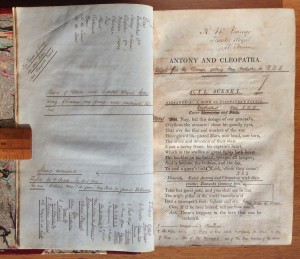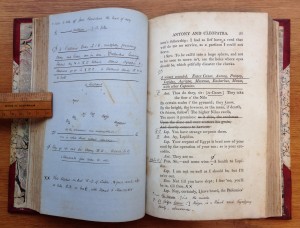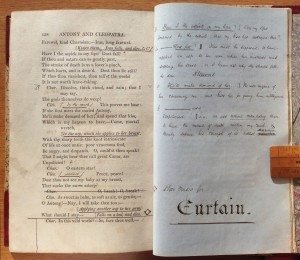On 23 February 1855, the steamship Pacific docked in
Melbourne harbour. Descending the gangway for his first tour of
Australia was the Irish actor Gustavus Brooke, along with his wife
Marianne, Brooke’s leading lady Fanny Cathcart, and his stage manager
Richard W. Younge.
How Younge worked up a play for performance can been seen in his interleaved copy of Antony and Cleopatra, A Tragedy ([London?], ca. 1800), highlighted in this week’s post, along with some commentary on its provenance and use.
The inscription shown above reads ‘R. W. Younge Theatre Royal Melbourne Feby 1856′. By ‘Theatre Royal’, Younge is most likely referring to Queen’s Theatre, also known as Queen’s Theatre Royal, where Brooke’s company opened with Othello to wide acclaim, and not the Theatre Royal owned by John Black. At the time of Younge’s February 1856 inscription, Black was in direct competition with the man responsible for Brooke’s Australian tour: the entrepreneurial actor-manager George Coppin, lessee of Queen’s Theatre and owner of the prefabricated Olympic. It was not until June 1856 that Coppin took over the Theatre Royal from his then insolvent rival, and so it is highly doubtful that Younge would have infringed upon his contractual obligations by being in the Theatre Royal before then.[1]
Potential confusion about the inscription aside, what makes this copy particularly interesting are Younge’s notes and textual edits.
Not a single page of printed text escaped his pen. Younge crossed out text, jotted down stage notes, cut entire scenes, changed characters, such as Demetrius and Philo being replaced by Enobarbus and Eros at the opening of Act 1, Scene 1 (see above image), and made numerous smaller alternations throughout the play in order to adapt the text to suit the production.
Younge clearly made good use of the interleaving. His notes range from single lines to full pages of text, including many explanations and interpretation of phrases, definitions of words, musical accompaniment and stage directions, and even the occasional sketch of the set.
Despite the amount of editing and annotation, no evidence could be found that Brooke and his company ever performed Antony and Cleopatra in Australia. Contemporary newspapers record the group performing scenes from Othello, Hamlet, Richard III, Macbeth, and Merchant of Venice. According to the Dictionary of the Australian Theatre, 1788-1914, Antony and Cleopatra was not performed at Melbourne’s Theatre Royal until 1867, six years after the actors returned to England.[2]
Perhaps Brooke and Younge found the existing repertoire sufficiently successful and did not feel the need to introduce scenes from another play.[3] Regardless of the reasons why Antony and Cleopatra was not used, this copy, with its copious notes and amendments, offers a fascinating study in nineteenth-century stage production and a fine connection with a booming Melbourne during Victoria’s early gold rush years.
—
Antony and Cleopatra; A Tragedy by William Shakespeare; Accurately Printed from the Text of Mr Steeven’s Last Edition ([London?], ca. 1800); from the library of Dr John Chapman with his bookplate; purchased by the University of Melbourne from the Chapman sale, Melbourne, 24-25 February 2004 (lot 340)
[1] According to Brooke’s entry in the Australian Dictionary of Biography, when the juvenile lead Robert James Heir married Fanny Cathcart the pair left Brooke’s company for an engagement at Black’s Theatre Royal. They were brought back by a court injunction. See H. L. Oppenheim, ‘Brooke, Gustavus Vaughan (1818–1866)’, Australian Dictionary of Biography, National Centre of Biography, Australian National University, http://adb.anu.edu.au/biography/brooke-gustavus-vaughan-3064/text4519, published in hardcopy 1969, accessed online 26 March 2014.
[2] Eric Irvin, Dictionary of the Australian Theatre, 1788-1914 (Sydney: Hale & Iremonger, 1985), 28.
[3] Along with the inscription, the fact the play went unused suggests Younge bought the book in Melbourne where he had it interleaved and bound. His working up of the text for a potential addition of Antony and Cleopatra to an already full programme seems more probable after the company’s arrival in Australia than having such plans in place at the start of the tour and then dropping them (My thanks to Ian Morrison, who was Curator of Special Collections at the University of Melbourne when this book was acquired, for discussing its provenance and history with me).
How Younge worked up a play for performance can been seen in his interleaved copy of Antony and Cleopatra, A Tragedy ([London?], ca. 1800), highlighted in this week’s post, along with some commentary on its provenance and use.
 |
| Half-title inscribed by Richard W. Younge |
The inscription shown above reads ‘R. W. Younge Theatre Royal Melbourne Feby 1856′. By ‘Theatre Royal’, Younge is most likely referring to Queen’s Theatre, also known as Queen’s Theatre Royal, where Brooke’s company opened with Othello to wide acclaim, and not the Theatre Royal owned by John Black. At the time of Younge’s February 1856 inscription, Black was in direct competition with the man responsible for Brooke’s Australian tour: the entrepreneurial actor-manager George Coppin, lessee of Queen’s Theatre and owner of the prefabricated Olympic. It was not until June 1856 that Coppin took over the Theatre Royal from his then insolvent rival, and so it is highly doubtful that Younge would have infringed upon his contractual obligations by being in the Theatre Royal before then.[1]
Potential confusion about the inscription aside, what makes this copy particularly interesting are Younge’s notes and textual edits.
 |
| Opening scene of play with annotations, notes, and a second inscription by Younge (p. [1]) |
Not a single page of printed text escaped his pen. Younge crossed out text, jotted down stage notes, cut entire scenes, changed characters, such as Demetrius and Philo being replaced by Enobarbus and Eros at the opening of Act 1, Scene 1 (see above image), and made numerous smaller alternations throughout the play in order to adapt the text to suit the production.
 |
| Younge’s changes to Act 2, Scene 2, with a further inscription (p. 26) |
Younge clearly made good use of the interleaving. His notes range from single lines to full pages of text, including many explanations and interpretation of phrases, definitions of words, musical accompaniment and stage directions, and even the occasional sketch of the set.
 |
| Sketch of set with stage notes (p. 50) |
 |
| Further stage notes (p. 51) |
Despite the amount of editing and annotation, no evidence could be found that Brooke and his company ever performed Antony and Cleopatra in Australia. Contemporary newspapers record the group performing scenes from Othello, Hamlet, Richard III, Macbeth, and Merchant of Venice. According to the Dictionary of the Australian Theatre, 1788-1914, Antony and Cleopatra was not performed at Melbourne’s Theatre Royal until 1867, six years after the actors returned to England.[2]
 |
| Final pages (p. 141). |
Perhaps Brooke and Younge found the existing repertoire sufficiently successful and did not feel the need to introduce scenes from another play.[3] Regardless of the reasons why Antony and Cleopatra was not used, this copy, with its copious notes and amendments, offers a fascinating study in nineteenth-century stage production and a fine connection with a booming Melbourne during Victoria’s early gold rush years.
Antony and Cleopatra; A Tragedy by William Shakespeare; Accurately Printed from the Text of Mr Steeven’s Last Edition ([London?], ca. 1800); from the library of Dr John Chapman with his bookplate; purchased by the University of Melbourne from the Chapman sale, Melbourne, 24-25 February 2004 (lot 340)
[1] According to Brooke’s entry in the Australian Dictionary of Biography, when the juvenile lead Robert James Heir married Fanny Cathcart the pair left Brooke’s company for an engagement at Black’s Theatre Royal. They were brought back by a court injunction. See H. L. Oppenheim, ‘Brooke, Gustavus Vaughan (1818–1866)’, Australian Dictionary of Biography, National Centre of Biography, Australian National University, http://adb.anu.edu.au/biography/brooke-gustavus-vaughan-3064/text4519, published in hardcopy 1969, accessed online 26 March 2014.
[2] Eric Irvin, Dictionary of the Australian Theatre, 1788-1914 (Sydney: Hale & Iremonger, 1985), 28.
[3] Along with the inscription, the fact the play went unused suggests Younge bought the book in Melbourne where he had it interleaved and bound. His working up of the text for a potential addition of Antony and Cleopatra to an already full programme seems more probable after the company’s arrival in Australia than having such plans in place at the start of the tour and then dropping them (My thanks to Ian Morrison, who was Curator of Special Collections at the University of Melbourne when this book was acquired, for discussing its provenance and history with me).

No comments:
Post a Comment